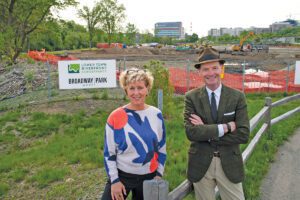The fourteen acres wedged between the river, the Broadway bridges, and the Amtrak railroad were once the site of a coal gasification plant that fueled Ann Arbor’s gas lights and stoves. Rendered obsolete by electrification and natural gas pipelines, it was demolished in the 1950s, and the site was turned into a service yard for utility work crews. It’s been vacant since 2009, as DTE worked to remove or contain the cancer-causing coal tars and other pollutants the plant left behind.

David Di Rita dedicated half of the fourteen-acre site to the newly created Lower Town Riverfront Conservancy and recruited former Ann Arbor Art Center CEO Marie Klopf to run it. A state “enhancement grant” kickstarted work this spring.
Four years ago, the city approved Detroit developer David Di Rita’s $100 million plan to build condos, a boutique hotel, and commercial space there. But that’s not what brought earthmovers to the site this spring. First, Di Rita and Marie Klopf, former head of the Ann Arbor Art Center, are turning half the site into “Broadway Park West.”
Klopf runs the Lower Town Riverfront Conservancy, the nonprofit Di Rita’s Roxbury Group created to own and maintain the project’s public spaces. These will include 1,200 feet of riverfront; a pavilion that can seat 300 for dinner and a lawn with room for 500 to 700 to attend parties, concerts, and events; a winter “ice skating ribbon” that turns into a “family-friendly water amenity” in the summer, and a pedestrian and bicycle bridge connecting them to the B2B Trail and the Argo Cascades. “This will be the place where everything converges and people can enjoy all the amenities along the Huron River,” says Klopf.
Initial funding is coming from a $20 million state “enhancement grant”—one of many approved by the legislature last July in what the Detroit News called a “$1 billion spending spree on projects … orchestrated largely behind closed doors.” The process was so secretive that even Ann Arbor’s own legislators didn’t know the conservancy was included until the bills came up for a vote. Yousef Rabhi, then state house minority leader and now a county commissioner, called the process “shady as hell.”
“Some of [the grants] were the kind of things most people would rally around,” says state senator Jeff Irwin. “Some of them you’d think, ‘That’s a terrible investment for the state of Michigan!’ And most of them are in the middle.”
No one in Lansing ever admitted to putting the $20 million into the bill. But Di Rita says even he doesn’t know. But “it’s not a secret,” Di Rita says, that “we went, on behalf of the conservancy—which was the recipient of the grant—up to Lansing [and] talked to legislators on both sides of the aisle.
“There was overwhelming support for this project from leadership in both parties. How they put together the legislation from that point is definitely above my pay grade. But unequivocally, a $20 million enhancement grant was awarded to the Lower Town Riverfront Conservancy to support Broadway Park’s development.”
Di Rita’s done something like this before, in Detroit, with the David Whitney Building. “There are some analogies,” he says. “That single building in downtown Detroit includes 100 apartments, a boutique hotel, retail … about the equivalent of everything that is being built on the Broadway Park site, other than the park itself.” He created a nonprofit conservancy there, too—though in that urban setting it’s restoring and maintaining an existing park rather than creating a new one. Unlike in Ann Arbor, the Grand Circus Park Conservancy doesn’t own the park, but it is responsible for its maintenance and administration, as well as for raising the money to sustain it.
Irwin was one of the people Di Rita’s people lobbied. “If I’m remembering correctly, Roxbury asked for a meeting and came into my office and talked with me about this project,” he says.
“They said, ‘Hey, look, we’ve got this Lower Town Conservancy, we think there are some public benefits to this project—site cleanup, affordable housing, but also a development of some public space—and here’s what we think it will look like, and here’s how much we’d like to have the state help us make all that happen.
“My reaction to it was, as long as this continues to be something that the city council is supportive of and is zoned appropriately … and everyone on the local level is green lights, I’ll say nice things about it.” But Irwin says he declined to promote it to the Lansing leaders who were carving up the state’s federal pandemic-relief windfall.
“If you’re asking me to take what limited influence I have to appropriate state dollars to special projects,” he explains, “I’ve got things that are going to be higher on my list that affect the interests of poor people, or folks struggling with mental illness, or supporting young people after school, all sorts of things that I’m asking for, and I can’t put this request above those requests.”
Irwin says doesn’t know who did request the $20 million. “I think maybe because of the media attention on the earmark, members who were more instrumental in pushing for it didn’t want to put their name on it,” he speculates. But for the money to be disbursed, someone had to step forward publicly as its sponsor.
So the “Roxbury Group circled back around—I don’t know, maybe a month later?—and said, ‘Hey, you know, we haven’t had anybody else to put in the paperwork yet, and we want to get this project going,’” he recalls. “‘Would you consider helping us get this paperwork moving so we can bring this money into the community and get this project started?’”
Irwin says he asked himself, “Is this project going to bring resources into the community? Is it going to make a difference in improving the riverfront? Is it going to clean up a polluted and unused piece of land? Is it going to provide some connectivity for our nonmotorized transit system and some public space that the public can enjoy?”
After some thought, Irwin says, he decided, “This is a decent project. As long as the city is still for it and these benefits are still on the table, then why don’t I just put my name on it?”
So he “ended up putting in the paperwork for it. Who championed this appropriation? I don’t really know. But ultimately, on paper, that’d be me.”
Di Rita’s thankful. He also says that the $20 million from the state does not get them over the finish line. They’re still fundraising. “We’re in the range of $23–24 million towards a goal of more along the lines of $30 to $32 million. We’re feeling good about where we are.”
And now that the money’s flowing, attention is shifting from who turned on the spigot to what the project will do for the city. In a January interview on WEMU-FM, mayor Christopher Taylor said that the site “has long been an open sore, and now it’s going to be a shining jewel.”
“It will be a different environment,” says Klopf. “We hope to have some food trucks available, where you could get hot chocolate, some food; it’ll be a wonderful gathering place for the community to enjoy year-round.”
In the meantime, she adds, “there have been some ‘noisy’ days at the park. The crews are finishing up the remediation phase of the development. Next up will be adding clean soil to prepare the space for infrastructure—utilities, roads, parking, and lighting. We remain scheduled to complete Broadway Park West by late spring or early summer 2024.”
Post-pandemic inflation has doubled the estimated cost of the project, to $200 million. Di Rita says that among Roxbury’s developments, this one is “in a class by itself” in terms of difficulty, because of the “sheer challenge and complexity of the project … It was a site that was still significantly contaminated, basically cut off from the city’s utilities and street grid, and as such largely inaccessible—and in the floodway, and shared an entrance with Amtrak!” (The train station’s long-term parking wraps around two sides of the property). But now that work is underway, he says, it’s been worth it.
Though a “once-in-a-century pandemic … turned everything on its head and exploded construction costs,” he says, “I think on some level, it also reinforced for people the importance of places like this.”



